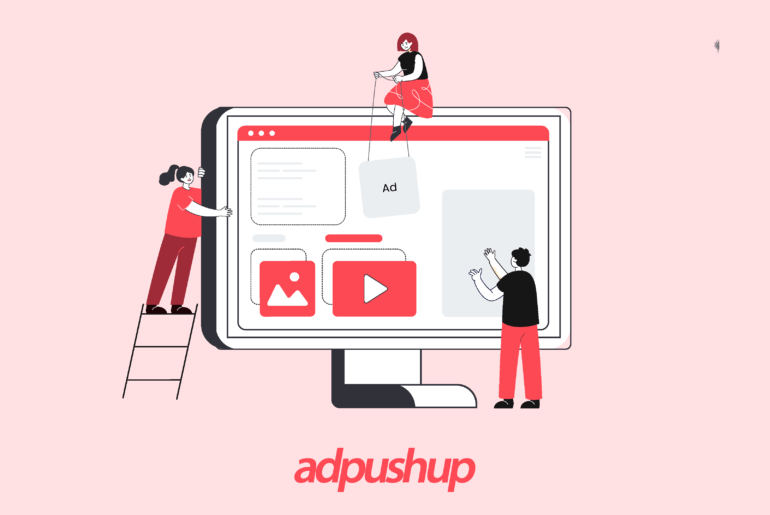Ad tech witnessed massive evolution in the last decade. The outcome? We got programs capable of managing most of the operational tasks. This led to the rise of programmatic advertising, which ultimately improved ROI for both advertisers and publishers.
Have you had enough of spending your hard-earned money on campaigns that fail to bring in the desired results?
The advertising industry has been evolving at a fast pace, thus conventional methods are no longer enough to keep up.
That’s exactly where programmatic advertising comes into the picture – a sophisticated and automated approach to automate your advertising efforts while also making way better returns.
But do you know how programmatic advertising continues revolutionizing the ad industry?
It is because of its ability to provide targeted and personalized ad experiences, cost-effectiveness, and adaptability to new technologies and advertising channels. That’s why it’s continuing to work wonders for both advertisers and publishers.
However, the fall of third-party cookies (which have grown quickly over the past 20 years) has raised concerns regarding the future of programmatic systems. Despite being on the verge of transformation, programmatic ads will continue to play a crucial part in digital marketing.
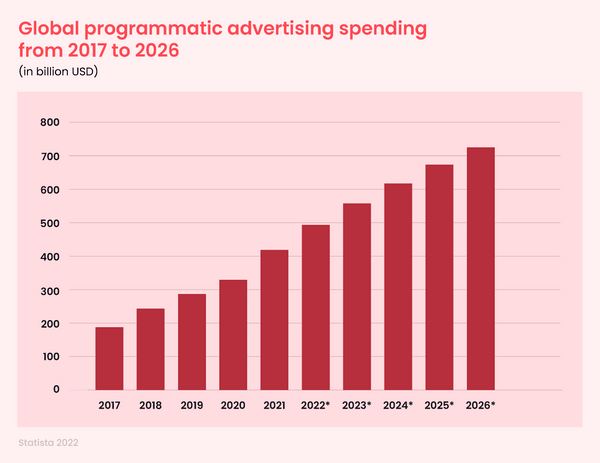
In fact, according to the Economic Times, programmatic advertising makes up 72% of the total market of digital displays. The amount spent on programmatic advertising by US marketers reached $106 billion in 2021, a 41% growth year over year. According to eMarketer, this figure will reach $123.2 billion this year in 2022.
This blog will help you if you’re interested in knowing more about programmatic advertising and its functions.
Also Read: 7 Best Examples of Programmatic Advertising That Needs Your Attention
What is Programmatic Advertising?
Programmatic advertising is a type of digital advertising that uses technology to automate the buying and selling of ad inventory in real-time. It uses multiple programs built inside it to carry out functions like selecting ad formats, adding floor prices, allowing targeting, generating required reports, and many more.
- Picture this, you want to sell your 300×300 ad unit to a buyer looking to target males aged between 18-30, living in California, interested in bikes and bid not below $0.5 CPM.
- For such specifications, a direct deal can be tricky, starting with finding such buyers and asking them to agree to your price.
- However, with programmatic display ads, you just need to create a bidding logic for the placement (300×300 ad unit), add all your requirements, and see bids coming in, in real-time.
- Programmatic advertising gives means to sell digital real estate faster and more efficiently while dodging major ad fraud. It can be categorized into two different separate sections, programmatic buying and programmatic selling. Naturally, these are just the two opposites that meet in the middle to exchange money for ad space.
Now that you know exactly what programmatic advertising is, you must be wondering how things were done before it was introduced.
Programmatic Advertising vs Non-Programmatic Advertising
It goes without saying that the traditional method of advertising required many strenuous efforts as well as time-consuming activities. Everything that is now automated through programmatic advertising required human efforts in the traditional route of advertising. This included:
- Finding the right people
- Human negotiations
- Contracts between publishers and advertisers
- Ad placement process
Now that things have evolved, we get to save a considerable amount of time by eliminating these processes on the humans’ end.
Technically speaking, both are just fancy ways of talking about automation, whether it is using automation and data while buying, advertising or selling using automated tools instead of a separate sales team calling companies that might be interested.
How Does Programmatic Ad Buying Work?
Here are steps involved in the process of programmatic buying:
Step 1. A user clicks on the website.
Step 2. The owner of the website puts the ad impression for auction (SSP).
Step 3. Advertisers offer various bids for the impression (DSP).
Step 4. The competing bids are analysed by AI algorithms to determine the most cost-effective bid.
Step 5. The advertiser with the highest bid wins the auction or ad impression.
Step 6. Finally, the ad is then served on the website to the user.
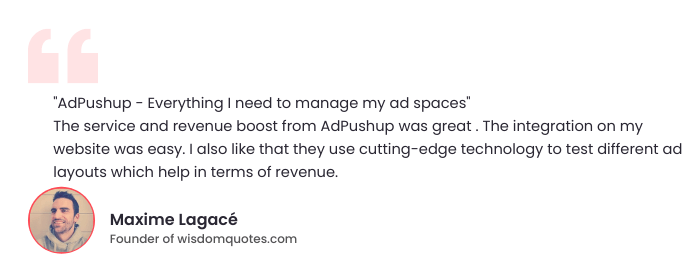
Evolution of Programmatic Advertising
Programmatic Display
Programmatic display or programmatic banner contributes to display advertising. It includes an exchange of inventory to show banners of the brand, when clicked, leads to the advertiser’s landing page.
Programmatic Video
YouTube ads are popular examples of programmatic video ads. However, website publishers are also running video ads on their websites thanks to out-stream video ads and automation offered by ad platforms like Google Ad Manager to easily implement them.
Programmatic Audio
Publishers with audio services like Google Play Music, Spotify, SoundCloud, and TuneIn monetize their audio inventory via programmatic audio. Unlike video ads, audio ads are yet to make it to the mainstream.
For publishers, programmatic selling has made everything easier by a multiplier of a hundred. No more sales teams calling people and no more worrying about empty advertising space because they can utilize real-time bidding auctions or guaranteed premium placements exchanges that can be found from multiple providers, the easiest of which to implement in comparison to the ROI is Google’s DoubleClick Ad Exchange.
Also Read: AMP Ads, CTV, & Cookieless Solutions For Improved Programmatic Advertising
How to Set up Programmatic Advertising?
To begin with programmatic advertising, there are a few steps you should follow. Take a look.
Understand Basics
First thing first, you need to be well-versed in the programmatic advertising nitty-gritty. This includes its different aspects like ad buying, targeting options, ad formats, ad placements, programmatic, etc.
Assess Your Inventory
Next, you need to thoroughly assess your ad inventory to determine the best way to sell it. You should start by analyzing what would work best. It is going to display advertising, native advertising, video ads, or anything else?
After that, pay attention to the target audience that is most likely to engage with ads. Not to mention, you should set the prices of your ad spaces smartly, specifically in a way that attracts advertisers.
For example, if you have a lot of video content, you may consider selling your video ad inventory. Another example is that if your website has content that attracts young people, you may want to consider targeting the advertisers that are looking for that demographic.
Single out Programmatic Platform
There are many programmatic platforms out there, however, not all of them may work best for you. Do your research and choose a platform that best fits your needs. While searching for it, make sure to factor in things like the size of your inventory, the type of ads you sell, and the level of control you would need over the ad selling process.
Integrate the Platform
Once you have finally found a programmatic platform to rely on, the next step is to integrate it into the ad-serving system. In order to do that, you will need to install a header bidding wrapper or integrate a programmatic tag into their ad server.
Cost of Implementation: Programmatic Advertising
The cost of programmatic advertising depends on various factors, such as:
- Ad format
- Ad placement
- Industry Type, etc.
It also depends on how it is priced using a CPM (cost per mille) model. CPM means costs per 1,000 ad impressions.
On average, Programmatic ads CPM usually cost somewhere between $0.40 and $2 or $3.
Programmatic CPM tends to be far cheaper than other platforms. For example, social media networks where CPM can go as high as an average of $7-$8.
So this means publishers and advertisers with limited budgets can also use programmatic ads in their marketing campaigns.
Also Check – A Guide to Programmatic Buying (2023)
What Are the Types of Programmatic Advertising?
Basis the type, further the programmatic sales model is designed for the exchange. Here are some of the popular ones:
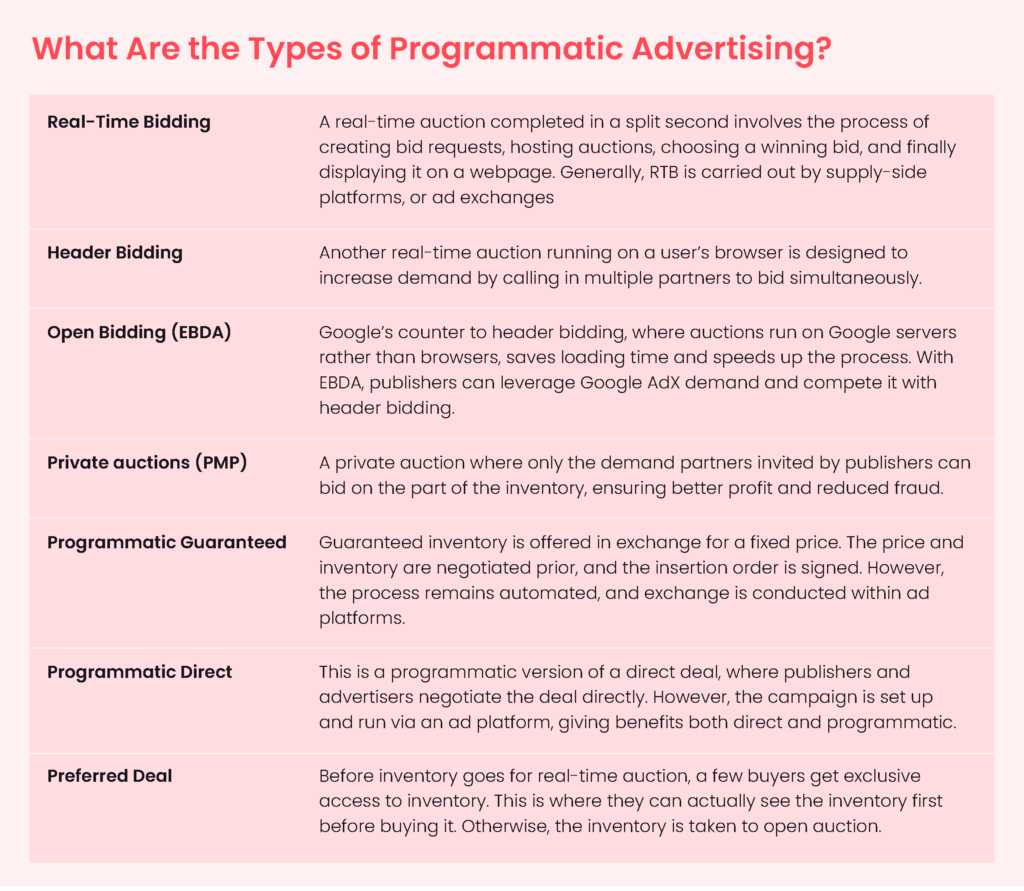
These are just a few popular ones. Many other methods (like daisy chaining) came and went within the programmatic universe as per their updated versions made to the market.
Auction Types – Programmatic Buying and Selling
Let’s take a look at the different auction types available for programmatic advertising. Each offers various advantages to publishers.
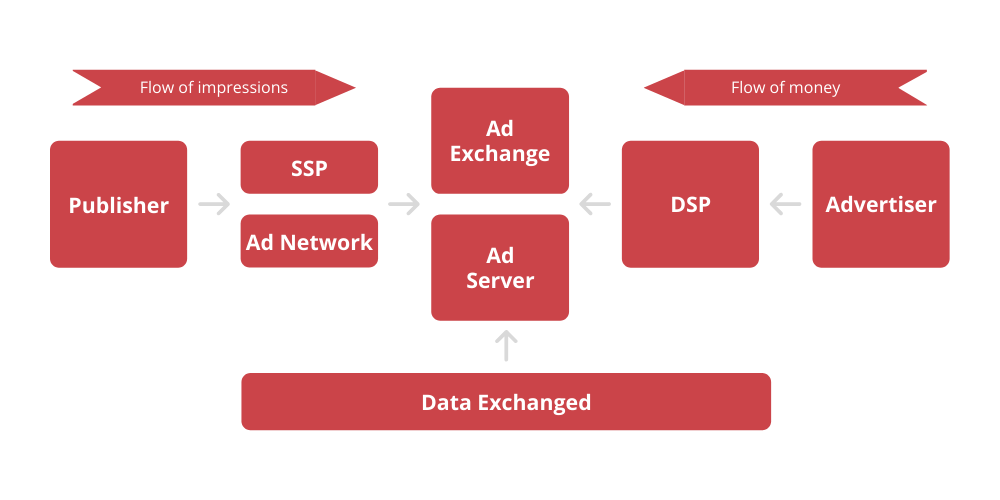
Programmatic Selling
Programmatic Selling is when a publisher sells inventory without directly communicating with the buyer. Programmatic selling can efficiently get scale, and drives prices down.
With programmatic selling, a publisher can look at the range of data on all ads sold. It also allow to efficiently manage all direct and indirect sales channels to maximize ad revenue. Programmatic selling adds a significant value, profitability, and ROI to ad revenues.
Also Read: How to Master Your Programmatic Buying in 2023: A Complete Guide
Programmatic Buying
The other side of the programmatic coin, programmatic buying, is whether advertisers and marketers get to set up detailed campaigns to reach their audience. Initially, the buying process involved cold outreach to multiple publishers with campaign proposals. This included hundreds of manual hours to close a publisher, not to mention the painstaking negotiation process.
But with programmatic buying, advertisers simply can toggle a few buttons to create a campaign, define the audience and set a budget.
Another factor that programmatic buying has that hooked advertisers is the data-driven side of it.
The analytical capabilities and statistics offered by many of the ad exchanges and ad platforms, used by advertisers to control their campaigns, enable advertisers to see exactly how many people have seen the ad and how many people have actually clicked the ad, the different demographics their advertisement is reaching and way more.
This allows advertisers to focus their advertising budgets more effectively, knowing they can target an ad to a user’s favourite colour.
And who knows, if your favourite colour is red, maybe next week you’ll see an advertisement for red T-shirts directed at you. And finally, understand the true power of targeting.
How is Programmatic Advertising Different from Real-Time Bidding?
Simply put, programmatic advertising is an automated process where media is bought and sold, It’s an umbrella term encompassing a bunch of automated technologies and processes, which makes the ad buying/selling process possible.
On the other hand, real-time bidding is a protocol, which makes the implementation of this process possible. In this method, ad impressions are sold within a real-time auction, where the highest bidder gets the ad space.
Programmatic Advertising vs DSP, DMP, Ad Exchange, and Ad Networks?
As mentioned earlier, the ecosystem of programmatic advertising includes several components, and DSP, DMP, Ad exchanges, etc are some of them. Let’s take a closer look.
DSP (Demand Side Platforms)– DSPs are developed to allow advertisers to buy the ad inventory across multiple ad exchanges.
DMP (Data Management Platform)– DMPs help advertisers to create more effective targeting strategies by using audience data.
Ad Exchange – There are plenty of ad exchanges out there, providing a platform for the publisher to sell their ad inventory.
Ad Network – Next in the process are the ad networks who connect the advertisers with the network of publishers looking to sell their ad space.
Together, all of these work in order to make programmatic advertising workable and as effective as possible for publishers and advertisers alike.
Biggest Programmatic Advertising Trends in 2023
Undoubtedly, programmatic advertising is evolving. That’s why different trends emerge that are worth paying attention to what’s happening with programmatic advertising in 2023 and beyond.
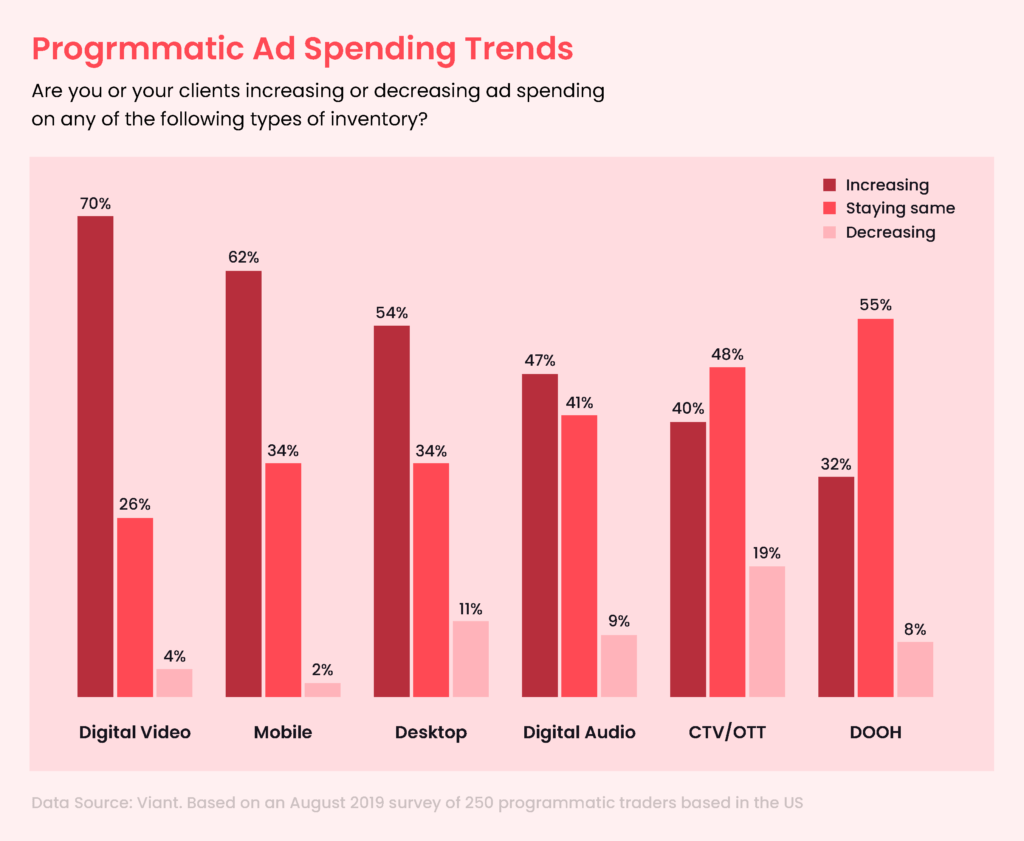
Programmatic Connected TV (CTV)
CTV is one of the biggest programmatic ad trends for 2022 and will be in 2023, also.
- Connected TV advertising spending will rise from $17.44 billion in 2022 to $27.47 billion by 2025.
- CTV programmatic ads have higher engagement rates than traditional ads.
- 81% of TV advertisers cited “targeting and efficiency” as the primary reason for shifting ad spending to programmatic CTV and OTT and moving away from linear / cable TV advertising. (Source: Mountain.com)
The opportunity for further growth within CTV programmatic advertising is wide-ranging. Unlike traditional methods of TV advertising, programmatic for CTV will bring a transformation to the whole process of TV advertising – from the buying process to planning to measurement and optimisation.
Cookieless Solutions
Google’s plan to eliminate third-party cookies leads to finding alternatives for programmatic marketing. First-party data is the biggest trend in programmatic advertising because of its precise detail that can provide incredible value for advertisers in terms of analysing browsing behaviour knowing user preferences, and segmenting audiences with the use of contextual targeting.
With advertisers and publishers seek alternatives to third-party cookies that allow them to target users when they visit apps or sites. Unified ID 2.0 is also in trend because of its open-source system that allows users to identify their preferences for the ads they wish to see.
According to Statista, spending on Unified identity solutions will reach $8.2 billion by 2024 in the US. However, Statista also found that 74% of marketers are looking for first-party data.
Implementation of Artificial Intelligence (AI) and ML
The implementation of Artificial intelligence and machine learning into programmatic advertising can be of great use to publishers. It helps to find patterns in multiple data points and predict results in real-time.
AI and ML technologies are now able to combine the mapping of ad viewing metrics with user data, which ensures that ads can be placed more accurately, resulting in lower costs.
Re-Emergence of Personalization
For impactful advertising that is also supported by programmatic capabilities to reach your audience. The use of personalized data feeds to target your audiences on a wider scale helps in higher conversion rates.
Programmatic ad tech, AI, and machine learning can now be used to optimize and offer personalized ads, which is beneficial for publishers.
First-party data will be crucial for brand success, and tapping into exciting segments such as CTV and mobile gaming could be the key to programmatic marketing moving into 2022.
Being creative, staying on the pulse of programmatic ad trends and utilising the power of a next-level creative management platform will be essential.
Ads.Txt For Ad Fraud Prevention
Ad spending continues to increase every year. Hence, publishers have to find new and effective ways to earn greater revenues as a result. But digital ad fraud is a problem that also continues to grow, resulting in enormous losses for companies.
Fortunately, there are several solutions in programmatic advertising for fighting fraud and making inventory purchases more secure and legitimate. One such solution is the ads.txt project created by the IAB.
Ads.txt not only make the supply chain transparent but also make things more complicated for fraudsters looking to sell inventory stolen from publishers.
In December 2020, IAB Tech Lab released ads.txt for connected TV as well because the CTV market required more transparency between media buyers and publishers.
How Publishers Benefit from Programmatic Advertising?
Reduce Human Error
The human brain is likely to forget numbers and confuse between names. However, a program won’t. By letting automation take care of numbers and constants, not only can human error be reduced, but it also speeds up the process.
Efficient Targeting and Retargeting
A well-targeted ad benefits users, advertisers and publishers, then why not utilize it? Programmatic advertising allows detailed targeting from user demographics to device type. Not limited to that, it further allows advertisers to reach users who have previously shown interest in the brand via retargeting.
Better Inventory Management
With growing internet usage, publishers’ traffic is increasing and hence the need for better inventory management. Publishers now have diverse audiences that require segmentation which can be easily done by automation provided by ad platforms. Next, the management of all ad types, placements, and their impact on user engagement can easily be monitored by programmatic services.
Create Exhaustive Reports
After the evolution of programmatic display, reporting quickly became popular because it offered an advanced understanding of growth opportunities to the ad operations team. With the help of programmatic, publishers can create exhaustive reports to track performance, find opportunities, and improve yield.
Increased Demand
The introduction of programmatic allowed global advertisers and marketers to reach any publishers with relevant audiences. In return, it increased demand volume on publishers’ traffic, allowing them to better monetize their traffic.
Prevent Ad Fraud
Looking at yield benefits, fraud prevention methods were soon automated. Many ad networks, SSPs, and exchanges added advanced fraud prevention programs to their platforms to avoid fraud with a growing yield. We have initiatives like ads.txt by IAB to curb domain spoofing and an inbuild traffic tracker by Google Analytics to filter out invalid traffic in place.
Read More: 5 Common Types of Ad Fraud (and How They Affect Publishers)
How to Do Ad Networks Benefit from Programmatic Advertising?
Not just the publishers, but the model of programmatic has something in store for ad networks as well. Ad networks get a great opportunity to scale their profits from programmatic ads as they can automate the process and match both parties, publisher and advertiser in a fraction of a second using DSP and SSPs. This efficiency not only saves time, but leads to increased revenue for ad networks.
Here are a few more benefits programmatic advertisers offer to ad networks:
- Increased Efficiency
- Enhanced Targeting
- Real-time optimization
- Access to Premium Inventory
- Greater Transparency
Are there any Drawbacks of Programmatic Advertising?
Although programmatic advertising comes with plenty of advantages. There are drawbacks too, however, there’s nothing to worry about as they can be avoided if things are done right.
Ad Fraud
As we all know programmatic advertising is an automated process that relies on certain algorithms. The process of media buying still takes place indirectly and it takes time to identify the bot traffic. Yes, you have heard it right. DSPs (Demand Side Platforms) and SSPs (Supply Side Platforms) still cannot immediately verify the source of traffic and how reliable it is.
Here is the estimated cost of digital ad fraud that took place worldwide between 2018-2023.
In-depth Programmatic Knowledge
This is more for the advertisers. When it comes to the human element of the process, automated ads have some kind of problem.
Different programmatic ad campaigns bring different results for advertisers. It takes someone with a plethora of experience and skills to create and manage campaigns. If an ad tech professional or an agency has inexperienced staff, it can end up making things problematic for advertisers by bringing little to no results at all.
It does not just affect the advertisers, it will also lead to irreparable ads showing up on publishers’ websites. This leads to fewer clicks on their website, meaning lower revenue.
Brand Safety
Another pitfall for publishers with programmatic advertising can be safety concerns. As mentioned earlier, publishers have less control over programmatic advertising, apparently, this also stands true for ad placement.
When an ad is placed next to inappropriate, sensitive, or offensive content, it can end up causing harm to publishers’ reputations and can also lead to negative associations with the brand.
How Can Publishers Combat Ad Fraud?
As we learned before, inadequate knowledge and expertise can result in various problems. This can also lead to ad fraud.
As a publisher, you must undertake some preventive measures in order to mitigate the risk of ad fraud. Here’s how you can do it.
Use Ads.txt
One of the effective ways to get rid of ad fraud is employing the use of Ads.txt. It helps you list the websites that are authorized to buy ad space. Once the list is posted, the ad buyers will be able to crawl the web searching for ads.txt files listed by publishers to come up with the list of authorized sellers.
Partner with Reliable Ad Networks
Next, single out reliable ad networks to work with. Make sure the ad networks you choose to work with have a proven track record of following the industry’s best practices and standards.
Ad Fraud Detection Tools
Implement ad fraud detection tools
Utilize ad fraud detection tools, such as pixel tracking and ad verification services, to help detect and prevent fraudulent activity. There are plenty of other tools as well you can find out there on the web. Get into their nitty-gritty details and find out what’s best for your website.
Educate yourself & team
Lastly, stay abreast of the latest news floating around ad frauds in the industry. At the same time, keep your team educated on the best practices to identify and avoid ad fraud.
Top Programmatic Advertising Platforms
The evolution of programmatic gave rise to multiple platforms that made inventory monetization more profitable but complex at the same time. Here are a few names that are thrown around in programmatic environments:
Ad Networks
The ad networks buy inventory from publishers, SSPs, and exchanges, and then segment and sell it to the highest bidder. Increasing revenue for publishers takes a small revenue share from publishers and advertisers.
Supply-Side Platforms (SSPs)
These are mostly responsible for managing publishers’ inventory, finding suitable buyers for them, and communicating with servers.
Demand-Side Platforms (DSPs)
The advertiser’s half of the process is managed by demand-side platforms. They offer campaign management, targeting enablement, and CPM optimization based on the budget for advertisers.
Ad Exchanges
This can be seen as a pool of inventory, organized and segmented for global advertisers to access, bid, and win as per the minimum requirements imposed by respective publishers. The ad Exchange is responsible for managing both supply-side and demand-side campaigns and matching them for higher yields.
Data Management Platforms (DMPs)
Publishers get tons of user data as users visit their websites. Similarly, bid operations generate data valuable to optimize future campaigns. To store, manage, and utilize all this data, publishers often use data management platforms.
Fraud Prevention Platforms
Just like optimization, there is a need for platforms to take care of security and maintain minimum standards in business practices. This is managed by fraud prevention platforms like Interactive Advertising Bureau (IAB) and Media Rating Council (MRC)
What Does Future Hold for Programmatic Advertising?
Speaking on the numbers, according to Statista, total ad spending on programmatic ads was worth 418 billion US dollars. This number is projected to reach almost 725 billion US dollars by the end of 2027. This implies programmatic advertising is not just the presence of the advertising industry, but a bright future as well.
For many, online advertising has become a go-to option for promoting their brand. Even though programmatic has a strong grasp over advertising, it’s not the only option that media buyers have.
Direct deals are another method where publishers and advertisers buy/sell media and that too with more control. With direct deals, as a publisher, you will always be aware of what kind of ads will be displayed on your website.
Lastly, there’s no doubt programmatic advertising is a widely adopted method, but due to the issues of having less control, there are people who prefer direct media buying.
Closing Words on Programmatic Advertising
It is evident today that the future of programmatic advertising is very bright, and it is the best time to step into the boat. When it comes to smaller brands, accessibility has increased to a great extent, and marketers can now make use of programmatic advertisements to reach their target audience more easily.
Whatever the demographics and markets, automated systems expand the reach, creating scope for newer opportunities as well. It’s better not to miss out on this opportunity and make the best of it while you can. The addition of many programmatic platforms is proof that programmatic is the future of ad tech.
We hope you understand how programmatic advertising works and what it can do to lift your ad revenue.
AdPushup offers a programmatic advertising technology that makes it easy for publishers to grow their revenue by up to 40%. Get the benefit of AdPushup programmatic advertising and networks to maximize results, sign up here to talk to our experts.
Key Takeaways from the Blog
- Programmatic advertising is constantly evolving and adapting to new technologies and trends. Publishers who stay up-to-date with the latest developments and best practices will be better positioned for success in the future.
- To succeed in programmatic advertising, publishers should have a strong understanding of their audience and data, implement ad viewability standards, and establish strong relationships with advertisers and programmatic partners.
- It relies on data and analytics to make informed decisions about ad placements, targeting, and optimization. Publishers must prioritize data privacy and transparency in their programmatic partnerships.
- Next, publishers can benefit from programmatic advertising by implementing ad viewability standards, leveraging data and analytics, and building strong relationships with advertisers and programmatic partners.
Overall, programmatic advertising is a valuable resource for publishers and advertisers looking to stay ahead of the curve in the rapidly evolving world of digital marketing.
FAQ Related to Programmatic Advertising
The recent Programmatic Advertising trends are:
a) First-party data solutions and Sunsetting cookies
b) Growth of Connected TV
c) Growth of white-label software
d) Video Advertisements
e) Gaming on Smartphones
f) Contextual Ads
g) Programmatic Audio
h) Rise of Digital out-of-home ads
The best place to start for those new to Programmatic Advertising is by doing some research. Learn about programmatic by attending webinars, listening to podcasts, and networking with others on best practices. As soon as you’re prepared to get going, start by creating your audience profiles, advertising plan, and KPIs.
This will assist you in determining which programmatic ad networks and exchanges are best for you. Also, don’t forget to read the Playbook, which contains information on using Programmatic Advertising on the Outbrain native ad network.
Despite the fact that Programmatic Advertising spending is on the rise, many digital marketers still struggle due to a lack of understanding of how Programmatic Advertising functions.
Programmatic Advertising is a particularly efficient approach to increasing brand recognition among large audiences because of its reach and scope. Consider using programmatic to distribute your message if your advertising campaign is targeted at the consideration/awareness stage.

Deepak has a keen eye for detail and a deep understanding of the ad tech landscape. Whether it’s through in-depth articles, thought-provoking insights, or compelling storytelling, he’s dedicated to helping people navigate the complex world of ad tech with the simplicity of his words.
